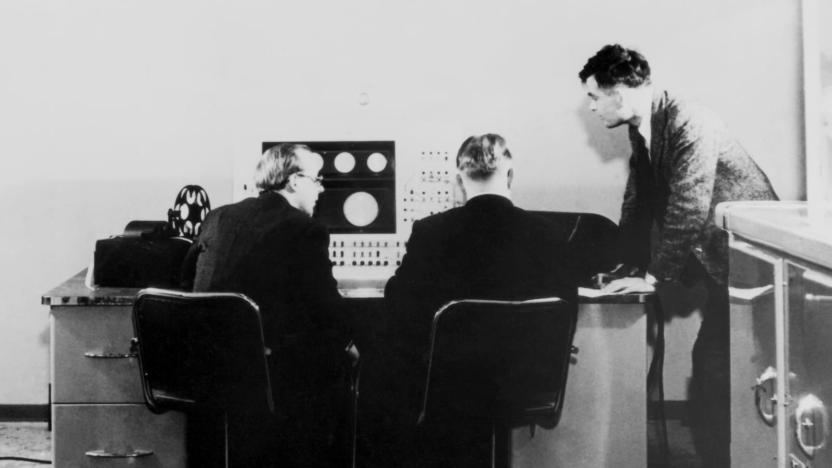electronicmusic
Latest

Roli Blocks is an affordable, modular way to make electronic music
British music-gear company Roli is mostly known for its attempts at reimagining the piano. The full-size Seaboard and smaller Seaboard Rise may bear similarities to traditional keyboards, but their rubberized, touch-sensitive buttons let you modulate, pitch-bend and slide between notes in a way that's far different from what you can do on a standard keyboard or synthesizer. However, price is a big barrier to entry -- the Seaboard Rise starts at $800, while its full-size counterpart will set you back $2,000 or more. But Roli has been working on a way to bring its unique music-creation tools down to a much lower price point, and it's taking the wraps off those efforts today. Roli Blocks are a set of modular synth controllers that snap together and hook up to your iPhone or iPad via Bluetooth. They're tiny and inexpensive: The main controller, called the Lightpad, is a small square (less than 4 inches to a side) that sells for $179. That's significantly cheaper than Roli's other products. And while you can't play the Lightpad like a keyboard, the short time I spent playing with it and the other Roli Blocks convinced me that it's still a powerful, flexible and fun music-making tool.

Alan Turing's groundbreaking synthesizer music restored
Alan Turing is known for a few small achievements, like helping end World War II, laying the groundwork for modern computers and developing the "Turing test" for machine intelligence. You may not be aware, however, that he paved the way for synthesizers and electronica by inventing the first computer-generated musical tones. A pair of researchers from the University of Cantebury have now restored the first-ever recording made from Turing's "synthesizer."

Deadmau5 is on Twitch
If it weren't for Deadmau5's terrible broadband speeds, he wouldn't be on Twitch, the live video-streaming site favored by gamers. Prior to moving to the Canadian countryside just outside of Toronto and building "a goddamned death ray" in his back yard to get paltry 5 Mbps downloads, the electronic musician, whose real name is Joel Zimmerman, had relied on a gigabit connection to broadcast music-making sessions in 2K resolution using his own data service provider. "The quality was pretty comparable [to Twitch], but I didn't have a social network behind it to help it along," he said during an interview from the first-ever TwitchCon. Now his TriCaster streaming setup is as good as "a $50,000 doorstop," and he instead uses the open-source OBS streaming software to broadcast games like Rocket League, and Counter-Strike: Global Offensive; and studio recording sessions from his basement like the rest of us.

Listen to a song made from recording thousands of industrial machines
We've heard music made from bats' echolocation signals and the sounds of glaciers before, but what about tunes composed with something a little more, say, industrial? And no, we aren't talking about Nine Inch Nails' classic The Downward Spiral. Think more along the lines of a song comprised of sounds from pneumatic equipment and welders and you're most of the way there. As spotted by Laughing Squid, musician Matthew Dear partnered with GE and recorded the acoustics used to diagnose the performance of turbines and jet engines, among other things, and the result is a dance-ready electronic track dubbed "Drop Science." Sure, artists including Amon Tobin have done similar sorts of things before, but not at such a grand scale. Curious to hear what it sounds like when thousands of machines are humming at peak performance? Check out the video and audio embedded below.

Scape, Brian Eno's new ambient music creation app is now available on the iPad (video)
Music making apps for the iPad are ten-a-penny, but when it's the brainchild of a super-producer like Brian Eno, you have to take notice. Scape is the third of his collaborations with Peter Chilvers after Bloom and Trope, an app that lets you generate ambient music with Eno's own sounds on a colorful, conceptual interface. Unlike standard beats'n'loops setups, each sound is tied to a series of rules -- including the time of day -- that ensures the tunes you create never play the same way twice. It's available from iTunes for $5.99 / £3.99, and who knows, maybe in a few years time, Coldplay'll come calling for your professional expertise.

Onyx Ashanti's beatjazz music machine does everything, looks good too (video)
Onyx Ashanti has sent us over a demo of his beatjazz controller, and we have to marvel at the direction he's taken with this custom electronic music machine following more modest efforts. Onyx's 3D-printed interface receives inputs from a voice / breath-operated synth in the headgear, while the two handheld controls incorporate accelerometers, joysticks and pressure-sensitive buttons. Using this kit and his own software, Onyx is able to create live digital music with an amount of control you would only expect from desktop-based production software. We've embedded two videos for your attention after the break -- a demo of his latest flashy build complete with lightsaber-like effects, and an earlier live performance that really shows what the beatjazz controller can do.

Kraftwerk performing 3D-enhanced retrospective concerts over 8 nights at MoMA
New York City isn't Europe and eight straight nights isn't exactly endless (though, it's plenty long if you're talking about lamp oil), but this humble metropolis is good enough for electronic and Krautrock pioneers Kraftwerk. The robo-rockers are heading to MoMa on April 10th and will be playing eight albums in chronological order, starting with Autobahn, over eight nights. The performances will sadly only feature one member of the classic lineup, but it will be augmented with 3D video and other visual media (presumably including neon lights). Tickets for the concert series, Kraftwerk-Retrospective 1 2 3 4 5 6 7 8, go on sale at noon on February 22nd for $25.[Image credit: Andréas Hagström, Wikipedia]

London Science Museum undusts Oramics machine, revisits OG electronic music innovation
Practicing its fist pump and channeling its inner Devo, the London Science Museum will be paying homage to electronic music pioneer Daphne Oram by resurrecting her old synthesizer last used in the '70s -- a device that relies on 35mm film to pump out jams. The classic clunker was found in a French barn last month and will be brought out into the open for the first time in forty years at the museum in old Blighty. "Oramics" operators "draw" music on ten strips of clear film to create a mask. The machine then reads the tape as differences in light and turns it into voltage control, which is used to switch oscillators and control the amplitude of the sound. The effect? A creepy vortex of haunting sounds. Fans of glow sticks and synth sounds can check out the exhibit until December, but if a trip to Londontown's not in your future, there's a video you should ogle after the break.

'Kraftwerk Who?' Pioneering '50s Synthesizer unearthed in French Barn
So there Dr. Mick Grierson was, wandering around a French barn, minding his own business when all of a sudden he happened upon an antique: one of the earliest modern synthesizers. Grierson, a professor at Goldsmiths University in London did what any expert in the field of electronic music would do, and whisked it back to the motherland for restoration. The Oram "Oramics" Synthesiser (sic) was built by Daphne Oram in 1957, a year before she co-founded the BBC Radiophonic Workshop to research and develop electronic music. Political wrangling within the corporation forced her to leave in 1959, and she retreated to a farm in nearby Kent to tinker with her invention. After her departure, the Workshop shot to fame for creating the original electronic theme to Doctor Who. In order to create music on the Oram, a composer painted waveforms directly onto 35mm film strips which were fed into the machine. Inside, photo-electronic cells read the light pattern and interpreted it as sound. Check out the video to see the arrival of the machinery back into England where it'll be on display all the way through December 2012. If you're really interested you can tap Dr Grierson's homebrewed Oramics iPhone app (linked below for your downloading pleasure) to create your own futuristic theme songs, '57-style.

Stanton's SCS.4DJ Digital DJ Mix Station up for Best Buy pre-order this month, in stores by July
When technology meets music, interesting things can happen -- for better or worse. In the case of Stanton's standalone SCS.4DJ Digital DJ Mix Station, anyone can try their hand at DJing. Notable hardware features include two weighted slabs with touch sensitivity, a 4.3-inch LCD, four USB ports for hooking up HDDs (two of which are hidden in handy storage slots), and a mic input for spitin' and spinnin'. If you're lacking in pro skills, the unit can automatically sync the tempos of whatever tracks are queued up, or even mix on its own like a player piano for your favorite block rockin' beats. Lastly, there's support for WAV, MP3, and AAC files, and any regrettable Lady Gaga and Skrillex fusion fun party mixes you make can be recorded live for transfer off the device. If you're psyched to start scratching, the SCS will be available for pre-order from Best Buy's website this month for $500 (pre-packaged skills don't come cheap), and in retail stores this July. You'll find the full press release after the break.

Eigenharp Alpha's biggest fan pens 11,000 word guide
Earlier this month, lucky musician Geert unboxed an Eigenharp Alpha for the whole world to see. Now he's jotted down a few thoughts on the 132-key digital instrument... oh hell, let's just call it a primer. Calling out years of musical study as proof he knows what he's talking about, the man delves into enough detail about the mind-blowing multi-instrument machine to teach Eigenharp 101. If you want to know whether dropping £3,995 on the musical creature would be worth your while, you'll find all you need to know at the source link, but be aware the sheer complexity here may serve to daunt some would-be casual learners. If you need to regain your enthusiasm afterwards though, there's no quicker way than watching an Eigenharp jam session -- we recorded one at the company's London HQ, and you'll find it after the break.

Homebrew MIDI controller takes performance to a new, flashier level (video)
While programs like Ableton Live have truly democratized electronic music making, most hardware interfaces can't hold a candle style-wise to traditional instruments (or even the MIDI gear of the Awesome 80s). Rather than merely bemoan this depressing fact, however, a musician from Zurich named Zander Ander has built his own controller -- and it's truly a thing of beauty. Based on the uCApps.de MIDI hardware platform, this thing employs custom acrylic knobs, colored LEDs, and a whole bunch of buttons to bring his DAW controls into the real world -- while kicking the ass of controllers like AKAI's APC40 in the process. But don't take our word for it! Check it out for yourself after the break.

Eigenharp Alpha unboxed by one lucky musician (video)
Dudes. DUDES. We know of at least one very happy electronic musician out there, as our pal Geert has finally got his hands on a £3,995 (roughly $5,760) Eigenharp Alpha. As you'd expect from something so pricey, it comes with a number of well-made accessories, including: a stand manufactured by K&M especially for the instrument, laptop / gig bag, cables, and a case. Jealous much? We know we are. Peep the video after the break.







